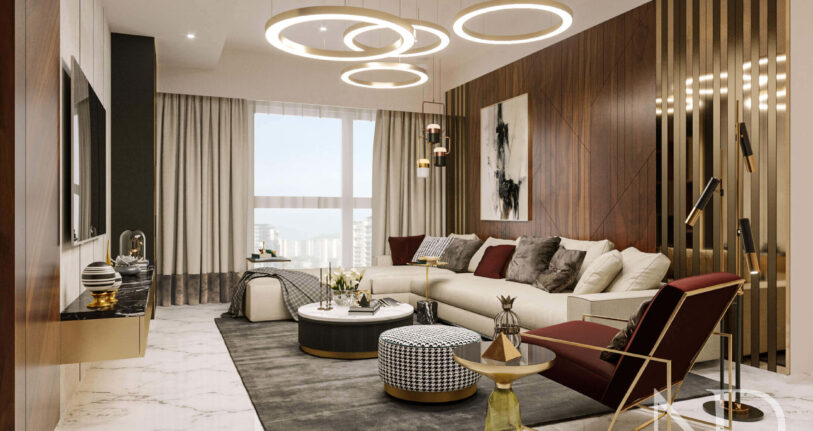How to Build a Successful Career as an Interior Designer in India?

About Interior Designer
Are you passionate about decorating your surroundings? You may be destined to become an Interior Designer if you answer ‘yes’ to these questions! Nowadays, interior designer careers have grown by leaps and bounds, whether in corporate or residential settings. Designing interiors for offices, homes, hotels, etc., can be transformed into masterpieces with a creative mind and a keen imagination.
The cost of land continues to increase day by day. The value of home values is not only increasing as a result of a value increase in the land itself, but also because consumers want more amenities and beautiful communities. Additionally, it is not limited to the exterior of the house. Every homeowner wants their homes to be functional and attractive. Today’s modest-sized homes offer all the amenities people need in a beautiful home. Learn how you can pursue an interior designer’s career in the near future.
Interior Designers are responsible for coming up with design ideas and conceptualising an environment that makes sense for the space. They are now in the position of taking their ideas and concepts from paper to reality. An important aspect of this business is drawing skills and creativity. Every year, more than thousands of Interior Designers graduate. Whether you are seeking an enviable career in Interior Design in India or anywhere else in the world, there is no shortage of options available to you.
What is interior design?
The interior design profession focuses on experiences with places and transforming them into beautiful environments. As a form of architecture, interior design entails designing manmade spaces to be comfortable and pleasant. It is the art and science of enhancing interior spaces. Interior designers are experts in the use of colours, fabrics and furniture as well as having a professional diploma or degree and training in this field.
Professional interior designers are responsible for designing the interior of people’s homes. However, the work doesn’t stop there. Creating something artistic for a house is not the only need of an interior designer; the job also involves finding the balance between functionality and aesthetics for the client. The designers take into account all the furnishings that must be present in a house, and how to arrange them in an empty flat to create a lively, beautiful home!
An interior designer’s job is to maximise the available space. Think about how much sunlight enters the room and how fresh the air is, as well as what arrangement would be most comfortable and beautiful for the customer.
Scope
- As lifestyles change and urbanisation accelerates, interior design has become one of the most in-demand professions in India.
- In recent years, interior designers have become increasingly in demand.
- To make their living spaces comfortable and happy, many people trust professionals to design them.
- Indian homes are getting smaller due to rising property prices, and interior designers are providing a solution to the space crisis.
- Interior design jobs could increase in the upcoming years since people are drawn to unique interiors and styles that stand out from the crowd.
Demand
It is expected that the interior design market will grow at an exponential rate by 2025. Within the next decade, the interior design market will see phenomenal growth.
According to the growing number of people turning to interior design in the future, interior designers’ demand will rise significantly. With more people becoming interested in interior design, the need for interior designers will certainly expand in the coming decades.
Interior design careers: an overview
Interior designers may be hired either during the design phase of a building or after the building is finished, depending on their intended function. A little knowledge of architecture is expected of Interior Designers for the former purpose.
- In the design process, the designer takes into account the purpose of the space or room, and what furnishings are necessary and what are not;
- The placement of windows and doors, as well as built-in furniture including shelves, can be planned by them from the beginning,
- As well as natural light and air, they consider the size and placement of the room.
- In addition to choosing the colour schemes, they decide what type and how much furniture to use;
- Some designers specialise in rooms such as bathrooms and kitchens or in certain styles such as Eco-friendly designs and feng-shui.
- Designers must adhere to customer tastes and budgets in all of the above cases. It is the designer’s responsibility to advise and optimise.
Interior designers should be knowledgeable about architecture, color schemes, materials and the cost of making the interiors, and which styles are popular. This person does not force knowledge on the client, but attempts to understand what the client wants. Interior designers will prosper if they are able to satisfy their customers, and there will be none who are unable to do so. It is therefore vital that interior designers can communicate well. Understanding the customer’s taste is essential.
Further, customers should be persuaded to choose the best design. The designer must be creative, but that doesn’t mean he can’t. To build an ideal house for the homeowner, the designer needs to blend different styles for originality and creativity. It’s only natural to want to make your home unique. Each and every one of us wants our own home.
Responsibilities of Interior Designer
Here are a few responsibilities that an interior designer handles. The following are typical interior design tasks:
- Conceptualising ideas through brainstorming
- Designing interior spaces by visualising them and drawing them
- Watching out for emerging trends
- A functional and aesthetic end-product is the primary goal
- You can bid on new projects by searching for them
- Decide the project’s purpose and requirements by determining the client’s goals and requirements
- The way people will move through the space and how it will be used should be considered
- Plan out the layout of the electrical and partition system in a preliminary design sketch
- Determine the materials, furnishings, wall finishes, flooring, plumbing fixtures, and lighting for each room
- Estimate the project costs and develop a schedule for the interior design project
- The responsibility of ordering materials and overseeing the installation of design elements
- Ensure that the building plans are implemented and coordinate with the general contractors
- Make sure the client is satisfied with the project when it is completed
As interior designers, we work closely with architects, civil engineers, mechanical engineers, along with construction labourers and helpers to determine how interior spaces will look, function, and be arranged. A designer must be able to read blueprints and understand building codes and permit requirements.
While some interior designers may draw by hand, the majority of their sketches are designed by computer-aided design (CAD) software. To create three-dimensional visualisations of construction elements, including walls and roofs, interior designers often employ building information modelling (BIM) software.
Specialised designers may specialise in particular structures or rooms, such as a specific style, type of building, hospital, or hotel. In some home-furnishing stores, designers assist clients with choosing materials and furnishings. In some cases designers work for furniture stores, giving customers advice on materials and furnishings.
Designs, plans, and drawings for interior installation and construction are produced by some interior designers. Building permits generally require structural plans, demolition plans, and electrical layouts. During the preliminary design phase, interior designers present designs as documents, which can be as simple as sketches or as comprehensive as construction plans, with schedules and attachments.
Eligibility to become Interior Designer
Following are the basic qualifications needed to become an interior designer. For each of the aspirants, this include their education qualifications, work experience and skills. Learn more about the job requirements by going through it.
1) Education Qualification
- Applicants preferentially should have a Bachelor’s or Master’s degree in interior design.
- B.Sc and B.A. degrees are popular in Interior Design, as are B.Des (Bachelor of Design), and a Master’s degree in Interior Design.
- Diplomas and certificates in Interior Design are highly advantageous.
2) Work Experience
Part-time work or internships can enhance skills and understanding without being mandatory. While work experience is not imperative, but it can surely enhance skills and knowledge. The fact that work experience is not obligatory does not mean it is not valuable or enriching.
3) Skills
Following are some of the most important skills for interior designers.
- Imagination, Insights, Ability to design, Adaptability, Solution-finding, A fresh perspective, The ability to communicate.
Let’s examine these skills in more detail and dig into these skills in depth now that we have a better understanding of them.
- Artistry: The sense of style of an interior designer helps develop aesthetically pleasing designs.
- Creativity and Imagination: The interior designer’s job requires creative thinking in selecting furnishings and fabrics and in creating spaces that serve the needs of the client and correspond to the lifestyle of the client.
- Focused on details. In order for interior designers’ drawings to be used by engineers and other designers, they need to measure spaces accurately and create drawings that are easily understood, so that other workers can make use of them.
- Communication skills. Communication is key for interior designers, who need to be able to work with clients and other stakeholders. Designers and engineers spend a great deal of their time seeking new clients and finding new work, collaborating with builders, engineers, and other designers and engineers, and completing ongoing projects.
- Problem-solving skills. A project’s interior designer must keep the project on schedule and on budget, while addressing issues such as construction delays and the cost of certain materials.
- Illustration. In order to understand how parts of a design will fit together to create a desired interior environment, interior designers require an understanding of proportion and visual awareness.
Courses to become an Interior Designer
Students can either choose a degree programme or a diploma programme to pursue this course of study. Depending on the program chosen, the admission procedure will be different. With a diploma degree, students who have completed their 12th grade are usually admitted directly into the program. A candidate who meets the qualifying mark is mostly preferred by top institutions for bachelor degrees. For studying for such exams, candidates may find it helpful to consult good interior design books and study material.
In order to pursue a career in interior design, students should take the following courses:
- BSc in Interior Design and Decoration – 3 Years
- Diploma in Interior Design – 1 Year
- Undergraduate Diploma in Interior Design – 3 Years
- Postgraduate Diploma in Interior and Spatial Design – 2 years
- Postgraduate Diploma in Interior Design – 2 Years
The interior design degree program prepares students for initial employment after graduation by providing internships, creating an interior design portfolio, building their personal brand and focusing on the business side of the profession.
Take a look at the top courses and fees, and institutes like JD Institute of Fashion Technology that one can consider in order to establish a career in Interior Design. Please browse the courses links or apply directly or fill out the Application Form. Our admission experts can help simplify the process by connecting you.
Types of Job Roles Interior Designer
Following completion of an interior design degree, candidates can choose from several job profiles in the field. To be creative is a prerequisite for all jobs. Listed below are some top interior designer job profiles:
- Interior and Spatial Designer: Designing the interior spaces of a building is the responsibility of these designers. Fittings and fixtures, as well as colour and lighting schemes, contribute to the design of these spaces. Commercial, domestic, and leisure settings are all potential work platforms for these designers.
- Lighting Designers: Designing for the natural environment is the sole focus for these designers. Light designers decide what type of lighting should be installed in office spaces, homes, or commercial outlets.
- Visual Merchandisers: Designers in this job profile are responsible for creating visual displays for retail outlets that are interesting and innovative. In order to attract customers to an outlet, it is needed to have visual merchandisers.
- Production Designer/Art Director: In the entertainment industry, these are the professionals. By putting their creativity and ideas into the project, they create, maintain, and execute ideas of the director. Television and film set designers design the sets we see on our screens. Set designs in movies and television are created by production designers.
- Exhibition Designer: The exhibition designer is primarily responsible for the creation of large exhibitions and projects. A designer of large-scale exhibitions plans and organises large-scale events. They are charged with communicating the message of their clients to the audience.
Designers can work on different fronts depending on their area of expertise in interior design. Designing interior spaces is a diversified field of expertise, and designers can focus on a variety of fronts based on their interests.
Interior designers work in the following sectors/industries
The following are some of the career paths available to interior designers. There are a number of employment opportunities available for interior designers.
- Firms that provide architectural services
- Wholesalers and retailers
- Companies that offer interior design services
- The Design Consultancy
- Companies involved in construction and builds building
- Companies that design sets for theatre, TV or film
- Organising companies for events
- Exhibition Centres
Top Recruiting Companies for Interior Designer
Several good companies are hiring interior designers from India. There are plenty of worthy interior design companies in India where interior designers can find a job. The following companies will not only provide exposure and experience, but will also enhance your brand.
- Interia
- Acropolis
- Tag Concepts
- Livspace
- Urban Ladder
- Effervescent Technologies Pvt. Ltd
- Bonito Designs
- Inch
- Homelane
Pay Scale/Salary of Interior Designer
Designers are paid based on their creativity and experience. Designers are compensated according to the degree of creativity and training they have. According to their job profiles and decades of experience, interior designers earn varying salaries. A salary breakdown for interior designers is based on their job titles and years of experience. The amount they can earn depends on the experience and industry in which they are employed. According to their experience and industry, they may earn anywhere from 3 lakhs per year to 9 lakhs per year.
Pros of becoming a Interior Designer
- Getting to work in a bright, colourful environment is a joy. It provides an opportunity to work in an ambiance filled with light and life.
- By combining your imagination with your creativity, you can turn your vision into a reality.
- During your job, you get to interact with a lot of people, which fosters networking opportunities.
- It is not uncommon for interior designers to earn a lot of money.
Cons of becoming a Interior Designer
- Manpower and resources are vital in order for an interior designer to execute their vision.
- Dealing with clients regarding payment is also one of the biggest challenges.
- In the field of interior design, there is a high level of competition.
- It takes a lot of time to complete one project before it is actually completed.
Career path for Interior Designer
While formal schooling is not required for interior design, those who have completed some course or diploma or hold a bachelor’s degree get an edge over those without. There is also a master’s degree and a doctoral degree program. It has also been observed that employers in interior design businesses are more inclined to hire employees with relevant academic backgrounds. A number of design schools offer interior designing courses, as well as masters degree programs in fine arts with an interior design focus.
What You Need to Do to Land a Job as an Interior Designer
- Get to know your field well by doing thorough research. Gather information about interior design and the various aspects in order to select a specific specialty.
- Prepare yourself by learning the tools needed. Make sure you learn important programs such as AutoCAD, Sketch Up, 3D Home-planner, Vector Works, etc. In order to start off strong and grow early in your career, every aspiring interior designer should learn these programs.
- Learn about interior design. Before you try to land a job in the field you should complete a formal education to become knowledgeable in the details of the work. Get a formal education in the field to become more familiar with its technical details before looking for a job.
- Creating a portfolio is a good idea. Careers are strengthened by portfolios. Your best work is collected in this book. Add sketches, before and after pictures of work sites, sample fabrics, etc., to your portfolio. An interior design portfolio will help you showcase your best work and demonstrate your credibility to potential clients.
- This internship is for training. Interior design is a profession where work experience is extremely important. You should intern for six to twelve months before seeking a job in interior design to learn about its critical aspects.
Future Prospects
In these days, interior designers are in high demand, both from the growing number of people who want to design their homes, as well as from restaurants, shops, offices, organisations, etc. Modern offices place a high value on aesthetics.
Each workplace requires an efficient design that helps them accomplish their tasks faster. In addition, cool interiors are often the reason why restaurants and shops succeed in business. A very important role has therefore been played by Interior Designers. As a result, the interior designer has become increasingly important.
Conclusion
You need a creative imagination above all else if you want to pursue interior design as a career. It’s a profession that requires both original art and practical know-how. Similarly, it asks you to establish your goodwill by giving your customers what they want. Therefore, it can be a rewarding profession for people with creativity and a willingness to accommodate others. This profession offers opportunities to pursue teaching, practicing in a firm or working as a freelancer. Combining technical knowledge with originality is essential to the job. Modern offices place a high value on aesthetics.
Talk to our experts if you’d like to learn more.






